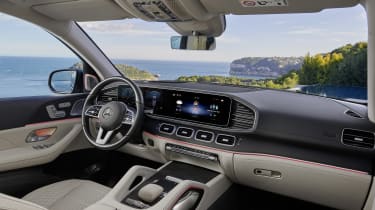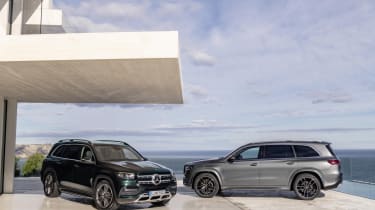New Mercedes GLS flagship SUV revealed
Mercedes’ seven-seat SUV is now even larger and more luxurious than before
The latest Mercedes GLS has been revealed at the New York Motor Show. When it goes on sale in autumn 2019, it’s promised to be as luxurious as the Mercedes S-Class and will offer plenty of comfort for all occupants - even those in the rear seats. The new GLS features updated exterior and interior styling, and will go head-to-head with the Audi Q7 and BMW X7.
A large upright grille takes up most of the front end between new super-bright LED headlights. The bonnet, air intakes and chrome-plated scuff guard have all been redesigned to add more presence and drama to the front of the car. At the rear, there are new 3D LED tail-lights, similar to those fitted to the new GLC. A chrome strip joins the lights, while there are two large exhaust finishers and another scuff plate integrated into the rear bumper.
Despite Mercedes’ best efforts, there’s no disguising the sheer size of the GLS. The largest of the company’s seven SUVs, it’s 77mm longer than the current model, with most of that increase coming between the wheels. That means there’s even more space in the second row of seats, and Mercedes claims that anyone up to 1.94m tall can fit in the third row. The middle seats also fold and slide forwards and backwards electronically, allowing easier access into the rear.
It’s clear that the GLS has been designed primarily for rear-seat passengers. Five-zone climate control is fitted as standard, the rearmost seats are heated and there are two USB charging points in the third row too. For the first time, you can choose between a six- or seven-seat configuration, with the former offering two sumptuous chairs instead of a standard bench.
You can also add massaging seats and a Rear Comfort Package Plus option, which includes a seven-inch tablet in the middle row of seats. This tablet can control all of the car’s infotainment and climate control functions. There’s also the option of having a pair of 11.6-inch touchscreens mounted in the back of the front headrests.
Those in the front seats won’t miss out. The cabin includes the company’s dual-screen setup - although they’re larger here at 12.3 inches each - with gesture control that can recognise whether the driver or passenger is using it. The MBUX infotainment system features artificial intelligence to predict what you’ll do next - if you regularly call someone or set a destination, the car can automatically bring up this information.
The GLS also includes a range of driving assistance features, including trailer manoeuvring assist, active stop-and-go assistance, route-based speed adaptation and traffic jam advance warnings. There’s also a specific car wash function for the first time, which gets the GLS ready for a carwash with a push of a button. It’ll close the windows, fold in the wing mirrors, set the climate control and deactivate the sensors for the automatic windscreen wipers.
Under the bonnet is a six-cylinder 3.0-litre diesel engine with either 285bhp or 325bhp. It should manage around 35mpg and already complies with the RDE2 emissions regulations, which come into force from January 2020. Four-wheel drive, a nine-speed automatic gearbox and air suspension are all fitted as standard.
Mercedes hasn’t revealed many figures regarding the car’s practicality, but the company has specified that up to 2,400 litres of space is available with both passenger rows folded. The seats fold flat into the floor, and you can fold all of them down with just one button press. There’s also the option to lower the load lip by 50mm to make loading large items easier.
The new GLS goes on sale in Europe in the third quarter of 2019. Prices haven’t been released yet, but we expect it to start from around £75,000.
Read our reviews of two of the GLS’ rivals, the Volvo XC90 and the Range Rover.
Recommended

New Mercedes CLA: full details and first ride in Merc’s next-gen EV
Most Popular

Omoda E5 targets rivals: now with zero deposit and APR

Ford Puma Gen-E driven: Electric charmer or too little, too late?
Tips & advice

Car dashboard warning lights: what does each symbol mean?

Electric car charging stations: public networks, charger types, apps and maps










